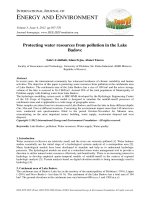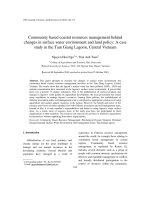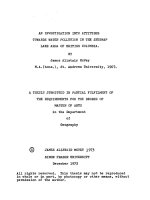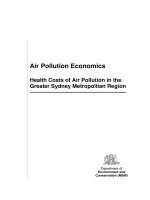environment pollution in the industriallzation
Bạn đang xem bản rút gọn của tài liệu. Xem và tải ngay bản đầy đủ của tài liệu tại đây (72.68 KB, 6 trang )
1
ENVIRONMENTAL POLLUTION IN THE INDUSTRIALIZATION PERIOD IN
VIETNAM – CAUSES AND REMEDIATION MEASURES
Prof. Dr. Sc. Pham Ngoc Dang
President, Vietnam Association for Civil Engineering Environment (VACEE)
ABSTRACT
Vietnam has been starting industrialization, modernization course since 1990s. The main
target is to convert Vietnam into industrialized country by the year of 2020, whereas the
industrial and construction products might contribute more than 50% of the GDP. The
GDP per capita in Vietnam was US$ 350 in 1990 and US$ 1,000 in 2009. It is projected
that GDP will reach US$ 2,000 per capita by the year of 2020 and US$ 3,000 by the year
of 2030.
Industrialization has been resulting in intensive urbanization. Urban population in 1990
was only 19% of the total population, while the ratio has increased up to 29.6% in 2009,
and, is being estimated to be 45% in the year of 2020.
Socio-economic development, intensive industrialization and urbanization are requiring
huge exploitation of natural resources, and, disposing different wastes and pollutants to the
environment, causing natural resources deterioration, pollution of water, air and soil.
The paper presents evolution of pollution status of the water, air and soil environment, as
well as solid waste management in Vietnam over last years. The paper also provides
recommendations for the actions in environmental protection, pollution prevention as well
as environment quality improvement in the coming period of the country.
KEY WORDS
Environmental Pollution, Environmental Protection, Industrialization, Urbanization
2
Vietnam has been starting industrialization, modernization course since 1990s. The main
target is to convert Vietnam into industrialized country by the year of 2020, whereas the
industrial and construction products might contribute more than 50% of the GDP. The
GDP per capita in Vietnam was US$ 350 in 1990 and US$ 1,000 in 2009. It is projected
that GDP will reach US$ 2,000 per capita by the year of 2020 and US$ 3,000 by the year
of 2030.
In 1991, the first industrial zone was appeared in Vietnam, and industrial zones continue
developing, became 65 industrial zones in 2000 and 223 industrial zones in 2009.
Moreover, Vietnam has set up 04 national main economic development areas (NMEDA)
(such as Northern NMEDA (represent Ha Noi City), Central NMEDA (represent Da Nang
City), South-East NMEDA (represent Ho Chi Minh City), Southern NMEDA (Can Tho
City)), and also established 23 complex economic areas in coastal and boundary areas,
which are next to China, Lao and Cambodia.
In 1990s, number of urban areas was only 500 areas, increased to 649 urban areas in 2000
and 715 urban areas in 2009. Urban population in 1990 was only 19% of the total
population, while the ratio has increased up to 29.6% in 2009, and, is being estimated to be
45% in the year of 2020.
Socio-economic development, intensive industrialization and urbanization are requiring
huge exploitation of natural resources, and, disposing different wastes and pollutants to the
environment. In the other hand, the main causes of environmental deterioration can be
considered such as: weakness in environmental management and polluted controlling, slow
development of environmental industries, cleaner technologies and reuse waste
technologies, and, weakness in environmental protection consciousness…
* URGENT PROBLEMS IN ENVIRONMENTAL POLLUTION
1. Urgent water pollution
- Surface water sources are being more polluted.
Untreated wastewater from domestic, service and production use are increasing and
directly eliminate to surface water source that make a serious pollution in almost lakes
and rivers in urban areas. Many rivers in urban areas, such as Cau river, Day river, Nhue
river, Thai Binh river, Dong Nai river, Sai Gon river. are polluted with BOD, Ammonia
content 1.2 to 2 time higher than Vietnamese standards. In Northern NMEDA, total
volume of wastewater, which has up to 300 ton/day BOD content, up to 350 ton/day
suspend solid, is 1 million m3/day; in which wastewater from industrial zone is 350,000
m3/day with 20 ton/day BOD content and 200 ton/day suspend solid, and, wastewater
discharge from urban and industrial areas is being estimated to be 2,556,000 m3 in 2020.
- Urban inundation in rainy season
3
In Vietnam, urban inundation is seriously in rain season, represent in Ha Noi City (because
of rain water) and Ho Chi Minh City (because of rain water and tidal water). There are 03
main flooding causes can be considered: (1) filling up pounds, lakes and low-land areas for
housing construction that reduces water storage capacity in urban areas; (2) making
concrete almost urban areas for road construction, that also reduces rain water infiltration;
(3) weakness from urban drainage system.
- Over exploitation of water supply resources (surface water and ground water) is among
huge challenges for future
Ratio of population that can be provided tap water is 80-90% in big urban areas, and only
50-70% in small urban areas. While forecast water supply demand in 2020 will be
increased 7 times for industrial use, 5 times for service uses, 2.1 times for domestic uses
than in 2005; quality and quantity of surface and ground water resources are decreasing
that is the huge challenges for future.
- Increase of water pollution in coastal areas
Whole polluted activities affect to environment in estuary and coastal areas. Besides,
harbor development, navigation, coastal tourism and fishery also directly affect to coastal
environment. The consequences are reducing mangrove ecosystem and decreasing natural
self cleaning system (natural adsorb pollutants). At present, coastal areas in many places
were polluted by oil, organic matters and heavy metals (copper, zinc).
2. Challenges in waste management
- Existing conditions and challenges in collection, classification and transportation of
waste matters
Domestic and industrial waste matters do not classify at source. Moreover, domestic and
other waste matters, including toxic waste matters are collected together and treated
unsatisfactory of environment protection.
Ratio of waste matters collected is 65-99% in big urban areas and new provincial
townships, only 15-50% in district towns, while urban waste matters will increase 3-4
times after 10 years.
- Existing conditions and challenges in treatment of waste matters
At present, burial method is main treatment method; however, almost landfills are in
unhygienic conditions.
Nowadays, construction of central toxic industrial waste matters treatment demand are
urgent matters.
- Spontaneous activities in recycle and reuse waste matters
Recycling and reusing waste matter are still spontaneous activities, and happen in sources
or landfills or collection stations, and are only 13-20% ratio.
3. Air and noise pollution
4
Dust pollution is highly affect to air environment in Vietnam, and is 2-3 times higher than
accepted standards in average, and can be 5-7 times higher in specific places. Dust and SO
2
pollution are seriously affect to air environment surrounding thermal power plants, cement
and brick factories and coal exploited areas in Quang Ninh province.
Some studies from epidemiology in Ha Noi, Hai Phong and Ho Chi Minh city show that
the proportion of people suffering from respiratory diseases, neurological diseases and
cardiovascular diseases in air and noise pollution areas, which are next to industrial areas,
is higher 2-5 times than un-pollution areas.
4. Alarming pollution in trade villages
At present, Vietnam has up to 2200 trade-villages, in which 60% in Red River Delta area
(Ha Noi has 245 trade-villages), 30% in Central area and 30% in South area.
Technology and production facilities in trade-villages are very backward; waste matters
almost do not collected and treated; production places alternate in living areas, so that
environment pollution directly affect to living and health conditions. Some trade-villages
are seriously polluted in water and air environment and waste matters such as: Duong O
paper trade-village (Bac Ninh), Minh Khai recycle plastic trade-village (Hung Yen), Phu
Do rice noodle, Duong Lieu vermicelli trade-village (Ha Noi)…
5.Threatening of natural ecosystem
- Natural forests and nature reserve areas, national parks are compromised
Development of transportation, urban area, industry, service and tourism put high pressure
in protection of natural forests and nature reserve areas, national gardens. For example:
illegal forest exploitation and hunting of wild animals are happening in Tam Dao, Ba Vi,
Cat Ba, Bai Tu national garden.
- Depression of mangroves and coral reefs
Because of urban development, new port/harbor construction and fishery development,
mangroves in Quang Ninh, Hai Phong, Thua Thien Hue, Da Nang, Quang Nam, Quang
Ngai, Vung Tau and Southern coastal areas are seriously declined.
Corals in Ha Long and Central coastal areas also declined, mainly causing sea water
pollution, especially turbidity and over exploitation.
- Lack of green areas
Standard of green tree area in urban areas in Vietnam is too small, only 2-4 m2/person in
average and only equal to 1/3 minimum green tree area in Vietnamese construction criteria.
* PROPOSAL OF REMEDIATION MEASURES AND IMPROVEMENT METHOD
Protection environment methods are proposed to prevent pollution and improve
environment quality, as follow:
1. Remediation measures – integration of environment protection into planning
5
- Integrate environment protection in social-economic development planning;
- Implement strategy environment impact assessment for development planning;
- Implement environment impact assessment for whole investment projects;
- Strictly fine for production units, which create seriously environment pollution, according
to decision No 64/2003/QĐ-TTg.
2. Pollution control and water environment protection
- Pollution control and surface environment protection
+ Organize and manage water environment base on river catchment;
+ Mitigate wastewater from generation source;
+ Plan construction of drainage system and wastewater treatment in urban areas;
+ Treat industrial wastewater.
- Pollution control and ground water environment protection
- Pollution control and sea water environment protection in coastal area
+ General management of coastal areas;
+ Control waste sources generated from navigation;
+ Control waste sources generated from coastal urban areas and coastal tourism areas;
+ Control wastewater from coastal mine exploitation, especially, coal exploitation in
Quang Ninh;
+ Control waste sources generated from fishery activities;
+ Prevent and rescue oil spill accidents.
3. Pollution control and air environment protection
- Mitigate air pollution generated from industrial activities
+ Reasonable arrangement of industrial zones each area;
+ Throughout treatment of environment pollution generated from old factories which
located alternate in inhabitant areas;
+ Mitigate air pollution generated from big industrial stations, especially, thermal power,
cement, metallurgical, chemical industry;
+ Mitigate dust generated from coal exploitation area
- Mitigate air pollution from urban transportation
4. Management planning of waste matters
- Planning of waste matters collection and treatment stations









